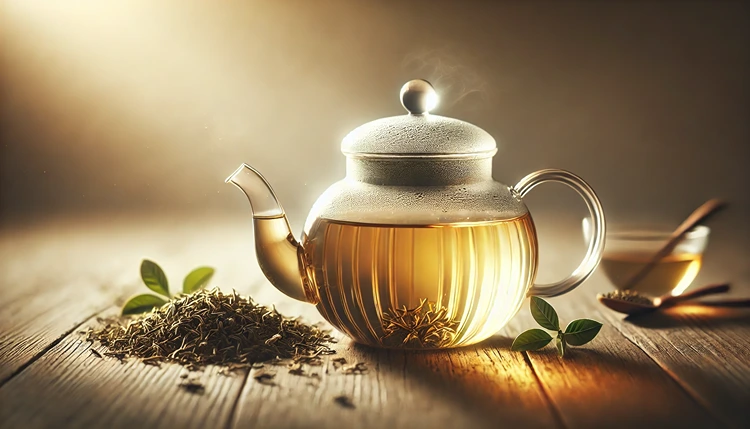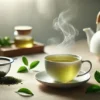White tea is a delicate, refreshing choice that many tea lovers swear by for its light flavor and subtle aroma. But getting it just right? That takes a bit of finesse. One of the most common questions I hear is, “How long should I steep white tea to get that perfect taste?” So, let’s dive into everything you need to know about steeping white tea at home.
What is the Best Steeping Time for White Tea?
White tea is all about balance. Too little steeping time and you miss out on its unique flavors; too much and it turns bitter. The sweet spot for most white teas falls between 3 to 5 minutes. However, this can depend on the type of white tea you’re using, the quality of the leaves, and personal taste.
For beginners, a good rule of thumb is to start at 3 minutes and increase the time if you feel the flavor needs a bit more depth. Remember, white tea leaves are more delicate than green or black tea, so they require a gentle touch.
Helpful Hint:
Use a kitchen timer to keep track of your steeping time. Even an extra minute or two can make a noticeable difference in taste, so precision matters.
Does Water Temperature Affect Steeping Time?
Absolutely! The water temperature plays a crucial role in how your white tea turns out. Ideally, the water for white tea should be between 160°F to 185°F (71°C to 85°C). Boiling water is a no-go since it can scorch the leaves and lead to bitterness.
If you don’t have a fancy kettle with temperature control, don’t worry. You can let boiling water cool down for about a minute before pouring it over your tea leaves.
What Happens if You Steep White Tea for Too Long?
Over-steeping white tea can lead to a bitter, astringent taste that overpowers its natural sweetness. Because the leaves are so tender, they can easily be “burned” by steeping too long or using water that’s too hot. Stick to the recommended times, but feel free to adjust based on your taste preference after a few tries.
How Much Tea Should You Use?
For white tea, the general recommendation is about 2 teaspoons of loose leaf tea per 8-ounce cup of water. If you’re using tea bags, just stick with one per cup. However, if you like your tea stronger, you can add an extra teaspoon.
Keep in mind that using too much tea can also lead to bitterness, so don’t go overboard. Start with the recommended amount and adjust from there.
Different Types of White Tea and Their Steeping Times
Not all white teas are created equal, and that means their steeping times can vary slightly. Here’s a quick breakdown:
- Bai Hao Yin Zhen (Silver Needle): This is one of the most prized white teas, made entirely from tea buds. Steeping time: 4-5 minutes.
- Bai Mu Dan (White Peony): A mix of buds and leaves, this tea is slightly stronger in flavor. Steeping time: 3-4 minutes.
- Shou Mei: A bolder white tea with more mature leaves. Steeping time: 4-5 minutes.
Each of these teas has its own character, so the key is to experiment and find the steeping time that works best for your palate.
How Can You Tell When White Tea is Ready?
Visually, white tea will have a pale golden hue when it’s ready. Taste-wise, it should be light, slightly sweet, and floral. If it’s too weak, let it steep for another 30 seconds to 1 minute. If it tastes too strong, try reducing the steeping time or adjusting the amount of tea leaves for your next brew.
Is it Better to Steep White Tea with a Lid?
Yes, steeping white tea with a lid helps trap the heat, allowing the leaves to infuse better and more evenly. If you’re using a teapot, make sure to cover it during steeping. Even if you’re steeping directly in a cup, using a saucer or small plate to cover the top can make a noticeable difference in flavor.
Helpful Hint:
If you don’t have a lid for your cup, try covering it with a small towel to keep the heat in. It works just as well and keeps your tea warm while steeping.
Can You Re-Steep White Tea?
Yes! One of the great things about white tea is that it can be re-steeped multiple times. In fact, some tea enthusiasts believe that white tea tastes even better after the second or third steep.
When re-steeping, increase the steeping time by about 30 seconds to 1 minute for each subsequent brew. This allows the flavor to fully develop and ensures you get the most out of your tea leaves.
White tea is particularly well-suited for re-steeping because it has a lower oxidation level than black or oolong tea. This means that the leaves can hold up to multiple infusions without losing their flavor.
Helpful Hint:
Don’t let your tea leaves dry out completely between steepings. Keep them in a little bit of water or re-steep within an hour or so to preserve their flavor and freshness.
Now that you’ve got the basics down, steeping white tea at home is all about finding that perfect balance that suits your taste buds. Whether you prefer it light and subtle or more robust, the key is experimenting with the time and water temperature until you find your ideal cup.
Should You Stir White Tea While Steeping?
White tea doesn’t need much intervention during steeping. In fact, it’s best to let the tea leaves gently infuse on their own. Stirring can sometimes disrupt the delicate flavors and even cause bitterness if you agitate the leaves too much. If you’re steeping loose-leaf tea, simply give the cup or teapot a little swirl at the start to help the leaves settle, but after that, let the magic happen without interference.
With that said, if you’re curious about how your tea is progressing, you can always give it a gentle stir toward the end of the steeping time to see if it’s reached the strength you like.
What is the Best Way to Strain White Tea?
Straining white tea is as important as steeping it properly. Because white tea often contains fine, fuzzy hairs from the tea buds, a fine mesh strainer is your best bet for catching these tiny particles. If you don’t mind a little sediment at the bottom of your cup, you can opt for a standard tea strainer, but for a cleaner brew, a fine mesh works best.
If you’re using a tea bag, you won’t need to worry about straining. Just remove the bag after steeping, and you’re good to go.
Can You Cold Brew White Tea?
Yes, you absolutely can! Cold brewing white tea is a fantastic way to enjoy its subtle flavors without worrying about bitterness, since cold water extracts the flavors more gently. The process is super simple and requires only patience.
To cold brew white tea, add 2 teaspoons of loose leaf white tea (or one tea bag) per 8 ounces of cold water. Let the tea steep in the refrigerator for about 6 to 8 hours. The result is a smooth, refreshing tea that’s perfect for hot days or when you’re in the mood for something light and hydrating.
Cold Brew White Tea
Ingredients
- 2 teaspoons loose leaf white tea (or 2 tea bags)
- 16 ounces cold, filtered water
Instructions
- Place the tea leaves (or tea bags) in a large jar or pitcher.
- Pour cold water over the tea and cover the jar or pitcher with a lid.
- Refrigerate for 6-8 hours.
- Strain the tea leaves or remove the tea bags and serve over ice.
Cold brewing brings out the gentle, floral notes of white tea and is less likely to result in a bitter cup. You can also add slices of fruit or herbs like mint for an extra twist!
Can You Add Sweeteners to White Tea?
While white tea is naturally sweet and light, some people prefer a little extra sweetness. You can add honey, agave syrup, or even a sprinkle of coconut sugar to enhance the flavor without overpowering it. Just keep in mind that white tea’s flavor is delicate, so you don’t want to add too much of anything that could mask its natural taste.
If you’re looking to keep things light, consider adding just a small amount of sweetener. It’s always easier to add more than to try to take it away!
Is It Okay to Add Milk to White Tea?
This is where things get a little tricky. White tea’s light and subtle flavor doesn’t always pair well with milk, which can easily overpower its delicate notes. However, if you enjoy a creamier texture, you can try adding a splash of plant-based milk, like almond or oat milk, which tends to be lighter than dairy.
Just remember, if you’re a purist, you may want to skip the milk altogether and savor the natural flavor of the tea. But if you like experimenting, go for it and see what works best for your taste!
How to Store White Tea Properly
Storing your white tea correctly is key to maintaining its flavor and freshness. White tea is particularly sensitive to light, heat, and moisture, so it’s important to keep it in an airtight container, away from direct sunlight and humidity. If stored properly, white tea can last for up to a year without losing much of its flavor.
Here are some tips for proper storage:
- Use an airtight container, preferably made of tin or glass with a seal.
- Store the container in a cool, dark place, like a pantry or cupboard.
- Avoid storing tea near strong odors, as it can absorb them easily.
If you’re using tea bags, it’s best to keep them in their original packaging until ready to use, and again, make sure they are sealed tightly between uses.
Can You Reheat White Tea?
Reheating white tea is generally not recommended. When tea is reheated, it can lose its delicate flavors and take on a more bitter taste. If you have leftover white tea, it’s better to enjoy it cold or at room temperature. If you really need to reheat it, do so gently over low heat and avoid boiling, as this will scorch the tea.
Another option is to repurpose your leftover white tea for a cold brew! Simply add ice, maybe a slice of lemon or a few mint leaves, and you’ve got a refreshing iced tea without wasting a drop.
FAQs
Wrapping Up
When it comes to white tea, mastering the perfect steeping time can make all the difference in taste. Whether you prefer your white tea hot or cold-brewed, the right balance of water temperature, steeping time, and tea-to-water ratio is key. With its delicate flavor and light, floral notes, white tea offers a soothing experience when brewed just right. Remember to experiment with different steeping times, temperatures, and even re-steeping to discover your ideal cup. Now that you’re equipped with the knowledge of how to steep white tea perfectly at home, enjoy experimenting with different types and brewing techniques to find what works best for you.
If you’re ready to take your tea game to the next level, don’t forget to share your new tea knowledge with friends, and maybe even try a tea-tasting session at home. Who knows? You might just become the go-to white tea expert in your circle.








